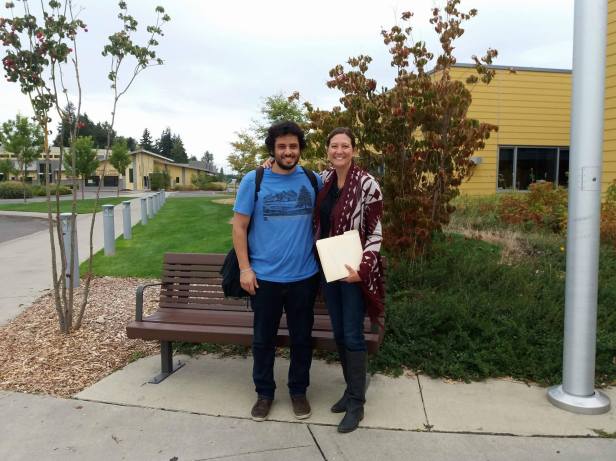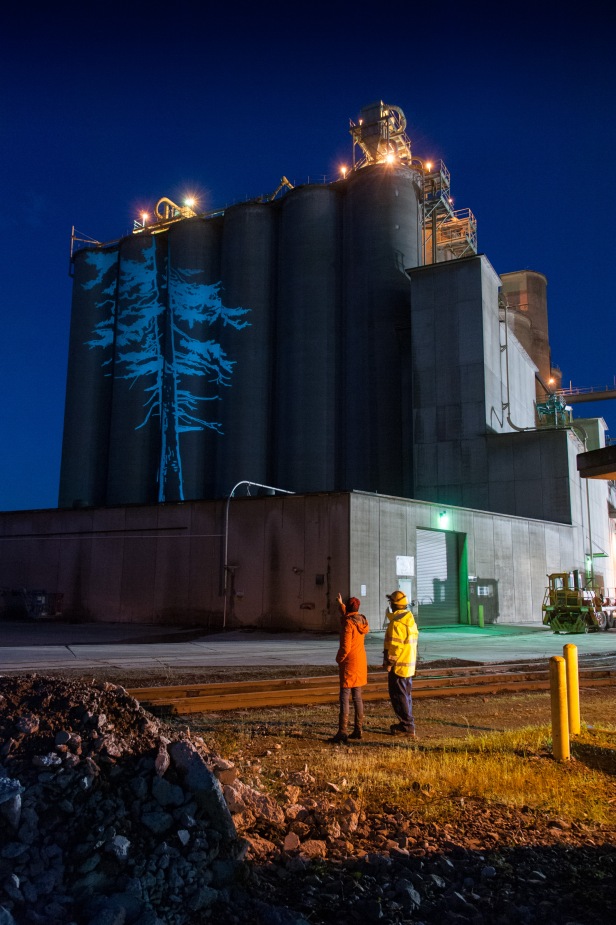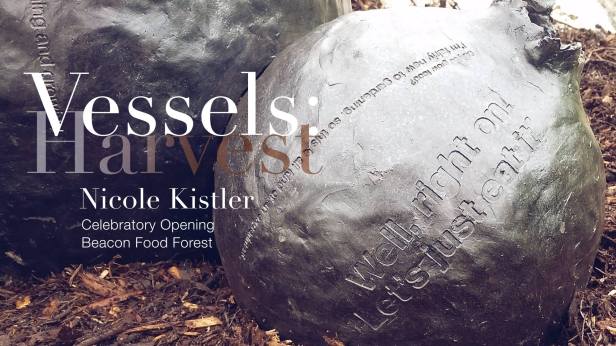
El 21 de junio pude entrevistar a la artista Nicole Kistler en Seattle. También es arquitecta paisajista. Esta doble experiencia la hace una artista muy cualificada para tratar con el espacio y trabajar con comunidades por lo que estoy muy interesado en su trabajo.
On June 21st, I met the artist Nicole Kistler in Seattle. She is also a landscape architect. This background makes her a very skilled artist in terms of dealing with space and working with communities. I am very interested in her expertise.
Organizó el proyecto Duwamish Revealed junto con la artista Sarah Kavage a quien ya he entrevistado. Aprendí sobre este proyecto entonces. Sin embargo, quería saber más. Por ejemplo, estaba interesado en conocer cómo la memoria del lugar y la memoria del río dio forma al proyecto. Me dijo que la investigación del lugar les llevó mucho tiempo y fue una parte importante del diseño del mismo. Descubrió en ese proceso la complejidad del contexto y cuán difícil es averiguar qué es lo que realmente sucedió allí. Este lugar, como otros muchos lugares en el Noroeste de Estados Unidos, antes de la ciudad de Seattle, antes de la llegada de los europeos, fue la tierra de los pueblos nativos americanos de la Costa Salish.
She organized the project Duwamish Revealed with the artist Sarah Kavage who I already interviewed. I learnt about this initiative then. However, I wanted to know more about it. For instance, I was interested in knowing how the memory of the place and the memory of the river informed the project. She told me that the research of the place took a long time and was an important part of the design of it. She discovered in that process the complexity of the context and the difficulty to figure out what happened there. This place, like a lot of other places in the Pacific Northwest, before the city of Seattle, before the European incomers, was the land of the Coast Salish Tribes.
Nicole Kistler destacó que este proyecto fue un gran aprendizaje para ella. Éste es un ejemplo del cambio de paradigma del que he estado hablando por un tiempo. Hemos pasado de la idea de un artista que trae soluciones, la mayoría de las veces soluciones preconcebidas que no son efectivas, a la idea de un artista que aprende y genera redes de aprendizaje. Por lo que sé, este rico y diverso proyecto acerca del Río Duwamish significó una enorme red de aprendizaje, preguntas, voces y diferentes acercamientos al lugar. Esto es una contribución muy destacable por parte del artista.
Nicole Kistler underlined than this project was a great learning for her. This is an example of the change of paradigm I have been talking about for a while. We have gone from an artist that brings solutions, most of the time preconceived solutions that are not effective, to an artist that learns and generates networks of learning. As far as I know, this rich and diverse project about the Duwamish River was a huge network of learning, questions, voices and approaches to the place. That is a remarkable contribution.
Ella también participó en el proyecto Duwamish Reveal con un proyecto artístico, Fantasmas Iluminados. Consistió en la proyección de un viejo árbol de la ribera de este río proyectado sobre los silos de una fábrica de cemento del puerto de Seattle. La especie proyectada fue un Douglas Fir. Lo proyectó a su tamaño real por lo que sólo fue visible la mitad, los silos no eran lo suficientemente grandes.
She also participated in the Duwamish Reveal with an art project, Illuminated Ghosts. This was a projection of an old growth tree of this river basin on industrial silos of a concrete factory based on the port of Seattle. The species projected was Douglas Fir. She projected the tree at full scale. These kind of trees are so big that only half of the tree projected was showed on the silos.
 Illuminated Ghosts (From the website of Duwamish Revealed) / Fantasmas Iluminados (página web del proyecto Duwamish Revealed).
Illuminated Ghosts (From the website of Duwamish Revealed) / Fantasmas Iluminados (página web del proyecto Duwamish Revealed).
El proyecto Living Barge puede ser también entendido como parte de esa recuperación de la memoria del lugar. Esta isla móvil fue plantada con árboles y arbustos nativos y generó conexiones con las comunidades donde estas plantas fueron finalmente plantadas. La artista también destacó que este proyecto fue muy útil para mostrar cómo las zonas industriales pueden presentar oportunidades para el cambio. Quizá recuperar la memoria ecológica puede ser el primer paso para imaginar un futuro diferente para estos lugares explotados.
The Living Barge Project could also be understood as part of that recovery of the memory of the place. This moving island was planted with different native trees and shrubs and generate connection with the communities where all these plants where finally planted. The artist also underlined that this project was useful to show how industrial areas could be opportunities for change. And perhaps recovering the ecological memory of the place can be the first step to envision a different future for these exploited places.
 The Living Burge (from the website of the artist) – The Living Garden (de la página web de la artista).
The Living Burge (from the website of the artist) – The Living Garden (de la página web de la artista).
Nicole Kistler fue contratada en 2012 para el proyecto AgriCULTURE. La pregunta de investigación con la que inicia este proyecto es cómo el arte en los huertos comunitarios puede promover las relaciones y actividad comunitarias. Así que diseñó un plan estratégico para la ciudad en colaboración con los agricultores y con otros miembros de la comunidad, con el fin de identificar las oportunidades para el arte. Sin embargo, este proyecto no continúa en marcha por la falta de fondos. El plan está disponible on-line e incluye un profundo análisis del contexto, los principios guía y una serie de recomendaciones para generar proyectos artísticos en estos huertos urbanos. Como sabéis soy de una zona de irrigación en Murcia, España, donde hay un montón de huertos privados de pequeño tamaño, que se mantienen principalmente como afición. Voy a estudiar el plan estratégico de Nicole Kistler para ver cómo podemos usar el arte en mi población para promover el sentimiento de vinculación con el lugar y la comunidad.
Nicole Kistler was commissioned in 2012 for the project AgriCULTURE. Her research question for this initiative was how we can use art to enhance community activities and relationships in the urban farming gardens. So she designed a master plan for the city working with the farmers and other members of the community to identify opportunities for art. However, this project is not continuing because of lack of funding. The master plan is available online and includes a deep analysis of the context, the guiding principles and a series of recommendation to promote art in these gardens. As you know, I am from an irrigation area in Murcia, Spain, where there are a lot of little and private gardens where people grow food, mostly for fun. I am going to study the master plan by Nicole Kistler to see how we can use art there in my town to promote the sense of place and the community.
Además de esto, Nicole Kistler tiene una larga experiencia trabajando con jardines comunitarios. Un ejemplo es el proyecto UpGarden (2012). Diseñó este jardín urbano con el arquitecto paisajista Eric Higbee donde se encontraba un a aparcamiento de más de 2.500 metros cuadrados. Este lugar proporciona más de 100 huertos para los residentes y hábitat para las abejas y los pájaros. La artista está promoviendo la vida y la comunidad en la ciudad. Otro ejemplo es el diseño de Seattle Tilth (2008), un plan de renovación de jardines. También desarrolló el proyecto Central District Public Art Plan (2011) que es una residencia para artistas que trabajan en espacios públicos.
In addition to that, Nicole Kistler has a long experience working with community gardens. An example is the project UpGarden (2012). She designed this urban garden with the landscape architect Eric Higbee where a 30,000 square feet parking lot used to be. This place is providing more than 100 plots for the residents and habitats for bees and birds. She is promoting life and community in the city. Another example is the design of Seattle Tilth (2008), a garden renovation plan. She also developed the Central District Public Art Plan (2011) which is a residency for artist that worked in the public space.
 UpGarden (from the website of the artist) / UpGarden (de la web de la artista).
UpGarden (from the website of the artist) / UpGarden (de la web de la artista).
Con toda esta experiencia trabajando con la comunidad, estaba interesado en saber más sobre cómo trabajar con las comunidades de manera exitosa. Por lo tanto, le pregunté cuáles son las claves para gestionar e incluir todos los puntos de vista de una comunidad. Dijo que cuando se trabaja con una comunidad es muy importante ser muy transparente en cuanto a lo que necesitas de ellos y sobre las expectativas sobre tu trabajo. También es crucial establecer límites entre las funciones de cada uno y gestionar adecuadamente el tiempo. También añadió que otro aspecto importante es diseñar estrategias que hagan a la comunidad participar realmente en el proceso como talleres con ejercicios específicos.
With all this experience working with the community, I was interested in knowing more about how to work with communities in a successful way. Therefore, I asked her what they keys are to manage and embrace all the different perspectives in the communities. She said that, when working with the community, it is very important to be very transparent in terms of what you want from them and their expectation about your work. It is also crucial to have boundaries between the roles of each one and to have a good managing of the time. She added that another important aspect is to design strategies to make the community really participate in the process like workshops with specific exercises.
Trabajó con las artistas Sarah Kavage y Vaughn Bell en el proyecto Watermarks en Seattle. El objetivo de este proyecto era identificar las nuevas líneas de costa resultantes de la subida de los niveles del mar provocados por el cambio climático. Las marcaron a través de una performance en la que iban dejando semillas a lo largo de esa línea. Tenían voluntarios que hablaban con el público y que más tarde compartieron con el grupo las preguntas que les hicieron. Ella formó parte de las personas que desarrollaron la performance. Según me cuenta, fue una experiencia muy transformadora. Creo que éste es un punto muy interesante: el proyecto artístico como un proceso de aprendizaje y no sólo para el público, sino también para los artistas a los que esa experiencia transforma de diferentes maneras.
She worked with Sarah Kavage and Vaughn Bell in the project Watermarks in Seattle. The goal of this project was identify the new shorelines of Seattle with the sea level rise caused by Climate Change. They marked it doing a performance in which they put seeds along that line. In addition, they had volunteers who interacted directly with the public. Afterwards these volunteers shared with the group the questions by the public. She was one of the performers and she told me that it was a very transformative experience for the people that participated doing the performance. I think this is a very interesting point: the art project as a learning process not only for the public but also for the artists that in different ways are transformed by the experience.
A parte de sus proyectos, también hablamos sobre diferentes temas relativos al trabajo artístico en espacios públicos. Como sabéis, estoy haciendo estas preguntas a diferentes artistas. La primera pregunta fue acerca de qué tipo de conocimiento y acercamiento necesita un artista para trabajar en un lugar concreto y hacer un proyecto significativo. Señaló que eso depende del lugar pero que hay algunas acciones básicas y fundamentales que desarrollar. Necesitas leer el paisaje, la topografía y cómo funciona la ciudad, hablar con la gente que vive allí, buscar información histórica y aprender por qué el lugar es cómo es. Además de esto, ella dijo que necesitas dedicar tiempo y amor a la gente.
Besides her projects we also talked about different issues regarding the work of artist working in the public space. As you know, I am asking these questions to different artist. The first question was about what kind of knowledge and approach an artist needs to work in a specific way to do a meaningful project. She pointed out that it depends on the place but there are some basic and fundamentals actions to develop. You need to read the landscape, the topography, how the city works, talk to the people who live there, look for historic information and learn why the place is like it is. In addition to that she said that you need to devote time and love for the people.
La segunda pregunta se refirió a cuáles son las diferencias entre trabajar como un extraño o como alguien del lugar. Apuntó algo muy interesante. Su experiencia es que es más fácil conseguir fondos para hacer tu trabajo fuera que en tu propia ciudad. Me pregunto si esto está realmente pasando, porqué, y dónde. Sospecho que posiblemente sea así. No es la primera vez que lo escucho.
The second question was regarding which are the differences between working as an outsider or as an insider. She said something very interesting. Her experience is that it is easier to get funds to work outside your community. I wonder if this is this really happening, why, and where. I suspect that it may be like that. It is not the first time that I have heard this.
Como dije antes, Nicole Kistler es una artista y una arquitecta del paisaje. Así que mi última pregunta es cuál es la diferencia entre un proyecto relativo a un lugar concreto en el que no hay artista o perspectiva artística y un proyecto donde sí que lo hay. En otras palabras, qué valores aporta un artista a proyectos como los que hemos hablado y que tratan sobre el medioambiente y la comunidad. Ella dijo que los artistas también intentan solucionar los retos de una manera poética y no sólo de una manera mecánica, y además los artistas intentan generan significado y eso es su prioridad. Así que la motivación es muy diferente.
Like I said before, Nicole Kistler is an artist and a landscape architect. So my last question was what the different between a project related to a specific place where there is no artist or where there is not an artistic perspective and a project where there is. In other words, what the values that an artist brings to projects like those we talked about that deal with the environment and the community are. She said that artists also try to solve in a poetic way and not only in a mechanical way, plus artists also try to generate meaning and that is their priority. So the motivations are different.
Finalmente, fuimos a Beacon Food Forest en Seattle para ver su nuevo trabajo, Vessels. Se trata de una serie de esculturas de acero. Son una especie de fruta/verdura que aparece entre las plantas del huerto, como nacidas de la tierra. En cada una de ellas hay un escrito que recoge historias de la comunidad que la artista ha estado recogiendo durante meses.
Finally, we went to Beacon Food Forest in Seattle to see her new work, Vessels. They are a series of cast iron sculptures installed in the garden. They are big beautiful fruits/vegetables that appear between the plants in the garden, like grown from the soil. There is writing in each of them about stories from the community that the artist has been collecting along months.
 (Photo from the opening of the work Vessels in Facebook – Foto de la inauguración del trabajo Vessels in Facebook)
(Photo from the opening of the work Vessels in Facebook – Foto de la inauguración del trabajo Vessels in Facebook)
Nicole Kistler tiene muchos otros proyectos interesantes que involucran a la comunidad. Recomiendo visitar su página web para aprender más sobre esos proyectos. Para mí, fue un privilegio conocer a Nicole Kistler, una artista con mucha experiencia trabajando con la comunidad y en relación a temas medioambientales que combina perspectivas poéticas y prácticas, si es que no son lo mismo. Gracias por compartir tu tiempo y tu trabajo conmigo.
Nicole Kistler has many other interesting projects that engage the community. I strongly recommend that you have a look of her website to learn more about those. For me, it was a privilege to meet Nicole Kistler, an artist with a lot of experience working with the community and dealing with environmental issues who combines poetical and practical perspectives, if they are not the same. Thanks for sharing your time and work with me.
Kistler, N. (2011). Nicole Kistler-Nicole Kistler Studio-Rethinking Landscapes. Recuperado el 18 de septiembre de 2017, de http://nicolekistler.com/
Interview with Nicole Kistler. June 21st, 2017. Seattle. Washington.
